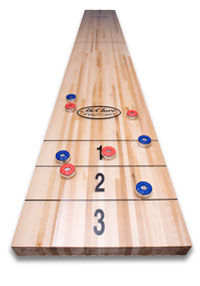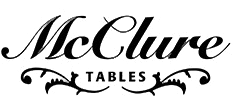Shuffleboard History
Like all popular activities, the game of shuffleboard enjoyed today by legions of followers the world over came from humble beginnings. Before there were shuffleboard leagues and expertly crafted tables, the game was developed as a simple bar sport that required only coins and a tabletop to get a competition going. The game may have gotten more serious as the years progressed, but at its core, shuffleboard retains the key characteristics that made it popular to begin with. Not only is it an activity that can be enjoyed by nearly anyone, its a social sport that brings people young and old together, whether it is played in a home game room or down at the local American Legion hall.
The birth of table shuffleboard
Shuffleboard has endured as a popular game for centuries, first showing up during the 1500s across the pond in the taverns and parlors of Great Britain. The original name of the earliest form of shuffleboard was simply "shove a penny," as that action was the basic gist of the sport. Players would shoot pennies and other coins down the end of a bar and aim to get as close to the edge as possible without having their penny fall off. The game was essentially a very basic version of today's "Knock-Off." It was far from just a bar activity, as members of the aristocracy even took a liking to it. Noblemen and Ladies commissioned tables for their homes and used coins specifically crafted for the game as pucks. The game got so popular that King Henry VIII eventually was forced to outlaw it, claiming the activity distracted soldiers who should be practicing their archery and sword-fighting skills.
The sport of shuffleboard comes Stateside
English settlers eventually brought shuffleboard to the United States where the game gained popularity in bars up and down the East Coast. However, shuffleboard didn't have the classy reputation it enjoyed back in England upon arriving in the U.S. Instead, the game was looked down upon by the pious as an activity for sinners, even being mentioned in the 1648 play "The Crucible" in a less than favorable light. In 1848, the game was even taken to court, as lawmakers unsuccessfully attempted to have shuffleboard banned from bars throughout the state. The case didn't stick, as the judge deemed it was a game of skill, not of chance, and therefore considered fair-play at bars without gambling licenses. By the late 19th Century, though, even the rich and powerful couldn't resist the sport, as tables were built for private residences by many of the era's most esteemed furniture designers.
Shuffleboard in modern times
The game finally made it to California in the early 1900s, and by the 1950s, was one of the most popular activities in the country. Leagues sprouted up coast to coast as the game was even covered on the sports pages of the nation's most popular newspapers. A big reason for the surge in popularity can be attributed to World War II, when soldiers from all over the country who cherished the sport during wartime brought the game home with them.
Popularity for the game began to wane during the 1960s and '70s as the game failed to attract a younger crowd, and other activities, like television, became premier entertainment options. However, the game retained a following and has seen something of a resurgence in recent years as players the world over still gather in droves for high profile competitions.
In 1979, the International Shuffleboard Association (ISA) was developed in St. Petersburg, Florida and now includes teams from the U.S., Canada, England, Australia, Japan and Brazil. In the '90s, the Table Shuffleboard Association (TSA) even developed its own Hall of Fame for players who helped keep the sport alive for centuries.
Whether you play at your local bar or have a game room at home, complete with an extra-large shuffleboard table of your very own, there's no denying that this game is one of the most exciting activities to enjoy with friends and family. It's because of this that shuffleboard has been played for over 500 years and will continue to be enjoyed for years to come.
began to wane during the 1960s and '70s as the game failed to attract a younger crowd, and other activities, like television, became premier entertainment options. However, the game retained a following and has seen something of a resurgence in recent years as players the world over still gather in droves for high profile competitions.
In 1979, the International Shuffleboard Association (ISA) was developed in St. Petersburg, Florida and now includes teams from the U.S., Canada, England, Australia, Japan and Brazil. In the '90s, the Table Shuffleboard Association (TSA) even developed its own Hall of Fame for players who helped keep the sport alive for centuries.
Whether you play at your local bar or have a game room at home, complete with an extra-large shuffleboard table of your very own, there's no denying that this game is one of the most exciting activities to enjoy with friends and family. It's because of this that shuffleboard has been played for over 500 years and will continue to be enjoyed for years to come.

